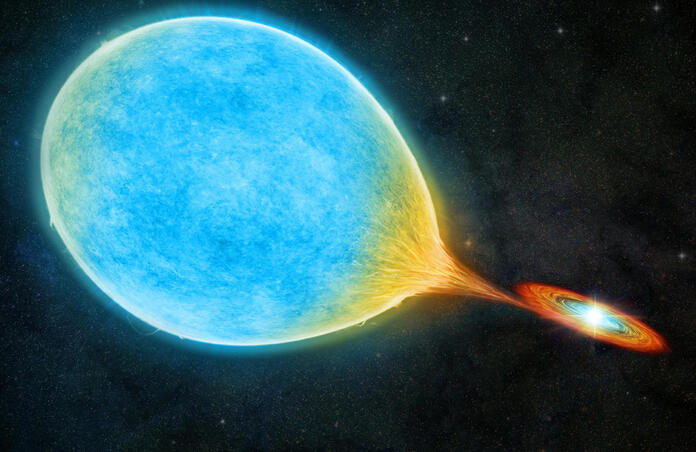Cataclysmic Variable System Discovered With Shortest Orbit Yet

Astronomers at MIT have discovered a stellar binary system named ZTF J1813+4251 with an extremely short orbit, the two stars circling each other every 51 minutes. The rapid system is one of the rare class of binaries, known as a cataclysmic variable comprising of a solar-like star in a tight orbit around a white dwarf – a hot and dense core of a dead low-mass star.
Within our galaxy, around 50% of stars are unaccompanied much like the sun. The other half make up systems comprising pairs or multiples of stars such as cataclysmic variables. These systems are typically small due to a close orbit, and an entire system can usually fit between the earth and the moon with orbital periods of 1-10 hours. Within these systems, the primary star (white dwarf) gains material from its sun-like companion via accretion, and since white dwarfs are such dense objects the gravitational potential energy is extremely large resulting in X-rays being transmitted during the process. Consequently, large variable flashes are given off by the system, leading astronomers in the 19th century to assume that this phenomenon is due to an unknown cataclysm, hence the name cataclysmic variable. There are two subclasses of these interesting star systems based on their outburst properties: classical novae and dwarf novae. Classical novae are caused by sudden nuclear fusion of hydrogen-rich material on the surface of the white dwarf, whereas dwarf novae form due to temporary increases in the rate of accretion onto the primary star.
The system, which is much more interesting than its name – ZTF J1813+4251 but perhaps just as complex is located 3000 light years from us within the Hercules constellation. Unlike previous detections of similar systems, observations caught the stars eclipsing each other several times which allowed them to make precise measurements of their masses, radii and orbital period. Additionally, the system has the shortest orbit ever detected at 51 minutes, which is rare given that only a handful of known cataclysmic variables possess orbits shorter than 75 minutes.
Observations of the dancing stars were made by the Zwicky Transient Facility (ZTF), a survey which takes high-resolution images of the sky by utilising a camera attached to a telescope at the Palomar Observatory in California. ZTF has taken over 1000 images of each star, with 1 billion stars being observed, documenting the changes in brightness over time. Kevin Burdge, a Pappalardo fellow in MIT’s Department of Physics was part of the team that made the discovery. Burdge started by scanning through the star catalogue for dramatic signals which signify a system with ultrashort orbits, notably those which had periods under an hour, flashing frequently. Using an algorithm, the team sifted through the billion stars to be left with around 1 million stars that display the flashes and among those, Burdge found ZTF J1813+4251 particularly interesting.
Upon further observations of the intriguing system using the W.M. Keck Observatory in Hawaii and Gran Telescopio Canarias in Spain, the research team discovered that the system was surprisingly ‘clean’, meaning that they could see a clear change in brightness with each eclipse. From this, they measured precise values for the system. It was found that the primary star was most likely a white dwarf around 1/100 the size of the sun and half the mass, whereas its companion was a sun-like Jupiter-sized star nearing the end of its life 1/10 the mass of the sun, confirming that this was indeed a cataclysmic variable system.
However, something wasn’t quite right- the stellar companion was similar to the sun, however, its orbit was dramatically shorter. Thankfully, the explanation was found by researchers 30 years ago who predicted that ultrashort orbits should exist as cataclysmic variables. As the companion stars’ hydrogen is eaten away by the white dwarf, it will burn out leaving a helium core which will keep the dead star in a tight orbit. Therefore, the rapid system observed is a cataclysmic variable in the process of transitioning from a hydrogen-rich to a helium-rich body.
To further confirm this, the team ran simulations of what the system would be doing at the present time and its subsequent evolution over the next hundreds of millions of years, and concluded that the system is currently in the transitioning stage with the companion star losing a lot of its hydrogen to the white dwarf. Consequently, in the next 70 million years the stars will move even closer to each other, reaching a swift orbit of 18 minutes before beginning to expand and drift apart.
More information on the discovery can be found in the paper published by the journal Nature.
--
Cover image: M. Weiss/Harvard & Smithsonian’s Center for Astrophysics.
Journal source: K.B. Burdge et al. A dense 0.1-solar-mass star in a 51-minute-orbital-period eclipsing binary. Nature, published online October 6, 2022; doi: 10.1038/s41586-022-05195-x
